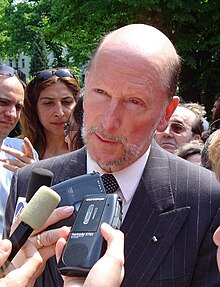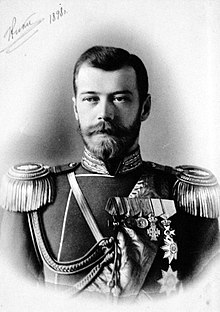|
Tsar
![[[Alphonse Mucha]]'s The Slav Epic cycle No.4: Tsar Simeon I of Bulgaria (1923)](http://upload.wikimedia.org/wikipedia/commons/thumb/5/5d/Car_Simeon_Bulharsky_-_Alfons_Mucha.jpg/220px-Car_Simeon_Bulharsky_-_Alfons_Mucha.jpg)  
Tsar (/zɑːr, (t)sɑːr/; also spelled czar, tzar, or csar; Bulgarian: цар, romanized: tsar; Russian: царь, romanized: tsar'; Serbian: цар, car) is a title historically used by Slavic monarchs. The term is derived from the Latin word caesar,[2] which was intended to mean emperor in the European medieval sense of the term—a ruler with the same rank as a Roman emperor, holding it by the approval of another emperor or a supreme ecclesiastical official—but was usually considered by Western Europeans to be equivalent to "king".[3][4][5] Tsar and its variants were the official titles in the First Bulgarian Empire (681–1018), Second Bulgarian Empire (1185–1396), the Kingdom of Bulgaria (1908–1946), the Serbian Empire (1346–1371), and the Tsardom of Russia (1547–1721). The first ruler to adopt the title tsar was Simeon I of Bulgaria.[6] Simeon II, the last tsar of Bulgaria, is the last person to hold this title. Meaning in Slavic languagesThe title tsar is derived from the Latin title for the Roman emperors, caesar.[2] The Greek equivalent of the Latin word imperator was the title autokrator. The term basileus was another term for the same position, but it was used differently depending on whether it was in a contemporary political context or in a historical or Biblical context. Bulgaria  In 705 Emperor Justinian II named Tervel of Bulgaria "caesar" (Greek: καῖσαρ), the first foreigner to receive this title, but his descendants continued to use Bulgar title "Kanasubigi". The sainted Boris I is sometimes retrospectively referred to as tsar, because at his time Bulgaria was converted to Christianity. However, the title "tsar" (and its Byzantine Greek equivalent basileus) was actually adopted and used for the first time by his son Simeon I, following a makeshift imperial coronation performed by the Patriarch of Constantinople in 913. After an attempt by the Byzantine Empire to revoke this major diplomatic concession and a decade of intensive warfare, the imperial title of the Bulgarian ruler was recognized by the Byzantine government in 924 and again at the formal conclusion of peace in 927. Since in Byzantine political theory there was place for only two emperors, Eastern and Western (as in the Late Roman Empire), the Bulgarian ruler was crowned basileus as "a spiritual son" of the Byzantine basileus.[8] It has been hypothesized that Simeon's title was also recognized by a papal mission to Bulgaria in or shortly after 925, as a concession in exchange for a settlement in the Bulgarian-Croatian conflict or a possible attempt to return Bulgaria to union with Rome. Thus, in the later diplomatic correspondence conducted in 1199–1204 between the Bulgarian ruler Kaloyan and Pope Innocent III, Kaloyan—whose self-assumed Latin title was "Imperator Bulgarorum et Blachorum"—claims that the imperial crowns of Simeon I, his son Peter I, and Samuel were somehow derived from the papacy. The pope, however, only speaks of reges (kings) of Bulgaria in his replies, and eventually grants only that lesser title to Kaloyan, who nevertheless proceeds to thank the pope for the "imperial title" conferred upon him.[9] After Bulgaria's liberation from the Ottomans in 1878, its new monarchs were at first autonomous prince (knyaz). With the declaration of full independence, Ferdinand I of Bulgaria adopted the traditional title "tsar" in 1908 and it was used until the abolition of the monarchy in 1946. However, these titles were not generally perceived as equivalents of "emperor" any longer. In the Bulgarian as in the Greek vernacular, the meaning of the title had shifted[10] (although Paisius' Slavonic-Bulgarian History (1760–1762) had still distinguished between the two concepts). Serbia The title of tsar (Serbian car) was used officially by two monarchs, the previous monarchial title being that of king (kralj). In 1345, Stefan Dušan began to style himself "Emperor of Serbs and Greeks" (the Greek renderings read "basileus and autokrator of Serbs and Romans"), and was crowned as such in Skopje on Easter (April 16) 1346 by the newly elevated Serbian patriarch, alongside the Bulgarian patriarch and archbishop of Ohrid. On the same occasion, he had his wife Helena of Bulgaria crowned as empress and his son associated in power as king. When Dušan died in 1355, his son Stefan Uroš V became the next emperor. The new emperor's uncle Simeon Uroš (Siniša) contested the succession and claimed the same titles as a dynast in Thessaly. After his death around 1370, he was succeeded in his claims by his son John Uroš, who retired to a monastery in about 1373.[citation needed] RussiaThe title tsar was used once by church officials of Kievan Rus' in the naming of Yaroslav the Wise, the grand prince of Kiev (r. 1019–1054). This may have related to Yaroslav's war against Byzantium and to his efforts to distance himself from Constantinople. However, other princes during the period of Kievan Rus' never styled themselves as tsars.[11] The first Russian ruler to openly break with the khan of the Golden Horde, Mikhail of Tver (r. 1285–1318), assumed the title basileus ton Ros,[12] as well as tsar.[13] Following his assertion of independence from the khan in 1476, Ivan III, the grand prince of Moscow (r. 1462–1505), adopted the title of sovereign of all Russia, and he later also started to use the title of tsar regularly in diplomatic relations with the West.[14] From about 1480, he is designated as imperator in his Latin correspondence, as keyser in his correspondence with the Swedish regent, and as kejser in his correspondence with the Danish king, Teutonic Knights, and the Hanseatic League. Ivan's son Vasily III continued using these titles. Sigismund von Herberstein (1486–1566) observed that the titles of kaiser and imperator were attempts to render the Russian term tsar into German and Latin, respectively.[15][full citation needed] The title-inflation related to Russia's growing ambitions to become an Orthodox "third Rome", after the fall of Constantinople in 1453. The monarch in Moscow was recognized as an emperor by Holy Roman Emperor Maximilian I in 1514.[16][17][note 1] However, the first Russian ruler to be formally crowned as tsar of all Russia was Ivan IV ("the Terrible"), in 1547. Some foreign ambassadors—namely, Herberstein (in 1516 and 1525), Daniel Printz a Buchau (in 1576 and 1578) and Just Juel (in 1709)—indicated that the word "tsar" should not be translated as "emperor", because it is applied by Russians to David, Solomon and other Biblical kings, who are simple reges.[note 2] On the other hand, Jacques Margeret, a bodyguard of False Demetrius I (r. 1605–1606), argues that the title of "tsar" is more honorable for Muscovites than "kaiser" or "king" exactly because it was God and not some earthly potentate who ordained to apply it to David, Solomon, and other kings of Israel.[18] Samuel Collins, a court physician to Tsar Alexis in 1659–66, styled the latter "Great Emperor", commenting that "as for the word Czar, it has so near relation to Cesar... that it may well be granted to signifie Emperor. The Russians would have it to be a higher title than King, and yet they call David Czar, and our kings, Kirrols, probably from Carolus Quintus, whose history they have among them".[19]  The title tsar remained in common usage, and also officially as part of various titles signifying rule over various states absorbed by the Russian monarchy (such as the former Tatar khanates and the Georgian Orthodox kingdom). In the 18th century, tsar was increasingly viewed as inferior to "emperor" or as highlighting the oriental side of the rank.[20] Upon annexing Crimea in 1783, Catherine the Great adopted the hellenicized title "tsaritsa of Tauric Chersonesos", rather than "tsaritsa of the Crimea". By 1815, when Russia annexed a large part of Poland, the title had clearly come to be interpreted in Russia as the equivalent of Polish król ("king"), and the Russian emperor assumed the title "tsar of Poland".[21] Among the indigenous peoples of Siberia and the Muslims of the Volga region, Central Asia and the Caucasus, the autocracy of the Russian Empire often became identified with the image of the "White Tsar" (Russian: Белый царь).[22] By 1894, when Nicholas II ascended the throne, the full title of the Russian rulers was
Metaphorical usesLike many lofty titles, such as mogul, tsar or czar has been used in English as a metaphor for positions of high authority since 1866 (referring to U.S. President Andrew Johnson), with a connotation of dictatorial powers and style, fitting since "autocrat" was an official title of the Russian Emperor (informally referred to as 'the tsar'). Similarly, Speaker of the House Thomas Brackett Reed was called "Czar Reed" for his dictatorial control of the House of Representatives in the 1880s and 1890s.[citation needed] In the United States and in the United Kingdom, the title "czar" is a colloquial term for certain high-level civil servants, such as the "drug czar" for the director of the Office of National Drug Control Policy (not to be confused with a drug baron), "terrorism czar" for a presidential advisor on terrorism policy, "cybersecurity czar" for the highest-ranking Department of Homeland Security official on computer security and information security policy, and "war czar" to oversee the wars in Iraq and Afghanistan. More specifically, a czar in the US government typically refers to a sub-cabinet-level advisor within the executive branch. One of the earliest known usages of the term was for Judge Kenesaw Mountain Landis, who was named commissioner of baseball, with broad powers to clean up the sport after it had been sullied by the Black Sox scandal of 1919.[24] See also
Notes
ReferencesCitations
Sources
External linksLook up tsar in Wiktionary, the free dictionary. Wikimedia Commons has media related to Tsars. |

